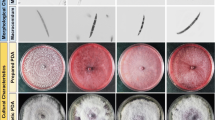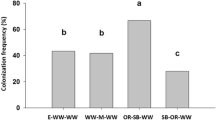Abstract
Pepper (Piper nigrum L.) root rot caused by Fusarium solani f. sp. piperis (FSP; teleomorph: Nectria haematococca f. sp. piperis) includes two symptom types called root rot (RR) type and stem rot (SR) type. In this study, the temporal and spatial associations between perithecial formation of FSP and development of SR were investigated in naturally infested fields to verify the hypothesis that ascospores from the perithecia are the major inoculum source of the SR type on vines in the field. In surveys of all vines in two neighboring pepper fields every month from December 2005 to November 2006, I mapped the locations of all vines with perithecia and all vines the SR type. The frequency of vines with perithecia increased during April and May, the late rainy season. In June, the early dry season, the number of vines with SR type greatly increased. The vertical range of perithecial formation on the vines extended to 200 cm in height, but was restricted to 30 cm in the dry season in both fields. The join-count statistics showed a significant spatial association between vines with perithecia and vines with SR type in one field (P = 0.042), while no significant spatial association was recognized in another field. The results suggested that ascospores from perithecia of FSP on pepper vines are likely to be one of the main inoculum sources of the SR type of the disease on adjacent vines, but they may not be the exclusive source.



Similar content being viewed by others
References
Aylor DE (1990) The role of intermittent wind in the dispersal of fungal pathogens. Annu Rev Phytopathol 28:73–92
Fukutomi M, Hirakata K, Hamada M (1982a) Outbreak of stem blight disease and the main factor in pepper cultivation area of Brazil (Abstract in Japanese). Ann Phytopathol Soc Jpn 48:355
Fukutomi M, Hirakata K, Hamada M (1982b) Past occurrence of stem and root rot diseases of black peppers in Amazon (in Japanese). Proc Kansai Pl Prot Soc 24:20–27
Gumpertz ML (1997) Testing binary response variables for spatial autocorrelation. In: Francl LJ, Neher DA (eds) Exercises in plant disease epidemiology. APS Press, St. Paul, pp 78–84
Hamada M, Uchida T, Tsuda M (1988) Ascospore dispersion of the causal agent of Nectria blight of Piper nigrum. Ann Phytopathol Soc Jpn 54:303–308
Ikeda K (2006) Ascocarp formation of the causal agent of root rot disease of black pepper by Fusarium solani f. sp. piperis in infected fields (Abstract in Japanese). Ann Phytopathol Soc Jpn 72:223
Ikeda K, Sakai H, Urushibara T, Shibata S, Shiraishi T, Yanagisawa K, Tsuchiya M (2005) The present state and occurrence cause of root rot disease of black pepper caused by Fusarium solani f. sp. piperis in the north of the State of Pará in Brazil (Abstract in Japanese). Ann Phytopathol Soc Jpn 71:222
Jee HJ, Ryu KY, Shim CK, Nam KW (2005) Occurrence of stem and fruit rot of paprika caused by Nectria heamatococca. Plant Pathol J 21:317–321
Karvy Comtrade (2008) Seasonal outlook report: pepper. Karvy Comtrade Ltd., Hyderabad, India. Available as PDF. http://www.karvycomtrade.com/downloads/karvySpecialReports/karvysSpecialReports_20080515_01.pdf. Accessed 15 May 2008
Lima Sena WLS, Rodrigues RC, Luz Freitas J, Costa CAC, Faro JD, Costa Moraes A (2004) Caracterização da materia orgânica em sistemas agroforestais no município de Tomé- Açu (PA) (in Portuguese). 5th Congresso Brasileiro de Sistemas Agroforestais, Curitiba, p 6
Madden LV, Hughes G, van den Bosch F (2007) Analysis of intensively mapped disease data. In: The study of plant disease epidemics. APS Press, St. Paul, pp 258–262
Phytopathological Society of Japan (ed) (2000) Common names of plant diseases in Japan. Japan Plant Protection Association, Tokyo
Shigesada N, Kawasaki K (1997) Biological invasions: theory and practice (Oxford series in ecology and evolution). Oxford University Press, New York
Tsuda M (1989) Pepper production and the disease in Brazil (2) (in Japanese). Agric Hortic 64:1159–1166
Acknowledgments
This study was conducted as part of the “Project of forestry conservation and environmental education in eastern Amazon” by the Japan International Cooperation Agency (JICA) and Gunma Prefecture. This study was supported by the pepper research team in Tomé-Açu Cultural Association. I also acknowledge the technical advice of Dr. Kazunori Ichikawa, Dr. Masashi Fujinaga, Mr. Toshimasa Shiraishi, Mr. Satoshi Shibata, Mr. Hiroshi Sakai and Mr. Toshihiko Urushibara.
Author information
Authors and Affiliations
Corresponding author
Rights and permissions
About this article
Cite this article
Ikeda, K. Role of perithecia as an inoculum source for stem rot type of pepper root rot caused by Fusarium solani f. sp. piperis (teleomorph: Nectria haematococca f. sp. piperis). J Gen Plant Pathol 76, 241–246 (2010). https://doi.org/10.1007/s10327-010-0237-2
Received:
Accepted:
Published:
Issue Date:
DOI: https://doi.org/10.1007/s10327-010-0237-2




